Featured Faculty
James J. O'Connor Professor of Managerial Economics and Decision Sciences; (Center) Co-Director of the Global Poverty Research Lab (GPRL)

Michael Meier
As China prepares for its 20th National Congress in October, when President Xi Jinping is expected to accept an unprecedented third term, many observers worry about uncertain days ahead, especially regarding Taiwan. But one doesn’t need a crystal ball to glimpse its future. China’s leaders, for their part, are looking at Russia.
China has mirrored Russia’s historical trajectory for most of the past 100 years. At the beginning of the twentieth century, both were large empires with outdated institutions that could not protect their people from foreign wars, corruption, inequality, and poverty. While Russia’s per capita income in 1900 was around one-third that of the United States, Chinese incomes were half those of Russia.
In 1949, the new People’s Republic was modeled, politically and economically, on the Soviet system. In both China and the Soviet Union, a command economy replaced markets, and the central government influenced every aspect of people’s lives—what they produced and ate, where they worked and lived, and what they could say, read, and write.
But Beijing and Moscow struggled to maintain production, because workers enjoyed very little reward for their labor. Among other strategies to compel people to work harder, the Soviet and Chinese governments established systems that threatened farmers with starvation if their production did not meet quotas set by the state. This approach led to more than seven million famine deaths in the Soviet Union (with the highest mortality rates in Ukraine) in 1932–33 and to 16.5-45 million famine deaths in China in 1959–61.
Not surprisingly, these enormous economic calamities posed a serious political threat to the regimes. After all, the Soviets and the Chinese Communists were supposed to be modernizers who would empower the people and deliver economic prosperity after centuries of oppression, corruption, and abject poverty.
To survive, each regime touted its role as a defender of the people against foreign invaders. The Soviet Union and China suffered more losses than any other country in World War II—with their death tolls reaching 20–27 million and 15–20 million, respectively. And in the decades thereafter, the Cold War kept alive the fear of foreign invasion and the legitimacy of authoritarian regimes.
Following the collapse of the Soviet Union in 1991, Russia became a model of what not to do. Its per capita income plummeted by 50 percent between 1989 and 1996, and did not recover to 1989 levels for another decade. Corruption and crime were rampant. Unemployment skyrocketed from 5 percent in 1991 to 13 percent in 1998, and social problems like alcoholism rose in tandem. In 1993, per capita alcohol consumption had reached 14.4 liters (of 100 percent alcohol), up from 11.7 liters in 1989. In 1994, 47 people per 100,000 died from alcohol-related causes—three times higher than the U.S. rate.
Since 2012, when Xi came to power, corruption has increased while inequality is unabated.
— Nancy Qian
The Communist Party of China learned from the Russian experience and pursued its liberalization with more care. Recognizing that rapid political liberalization in Russia had ended up sweeping the Communist Party from power, and that auctioning off state assets had given rise to billionaire “oligarchs,” the CPC took pains to avoid the same fate. By carefully controlling privatization and political reforms such as local elections, it restructured the economy gradually, making progress through trial and error, and avoided sudden and destabilizing shifts in the distribution of wealth.
Liberalization transformed China and Russia from relatively equal economies to ones where the top 1 percent own one-third of the wealth. In 2015, the bottom 25 percent of Chinese households owned only 1 percent of the country’s wealth, while the bottom half of Russian households owned just 15 percent.
Like the Russian oligarchs, the new Chinese elites are usually perceived as egotistical, corrupt threats to state authority. In Russia, President Vladimir Putin gained popularity for “defeating” the oligarchs and bringing back law and order. In China, Xi’s aggressive campaigns to reduce corruption and curb the power of new billionaires—such as Alibaba founder Jack Ma—have been similarly popular.
The renewed rivalry with the West has also boosted both leaders’ popularity. Many Russians and Chinese have been convinced that the West—through NATO’s post-1991 enlargement and U.S. support of Taiwan—is a threat to their sovereignty. Polls suggest that up to three-quarters of Russians and most Chinese support Russia’s invasion of Ukraine.
While times have changed, the playbook for popularity has not. Strongmen still appeal to the people by presenting themselves as defenders of equality against poverty, corruption, and foreign invaders. The more controversial their hold on power is, the more they need success in these fights. The less success they have in the economic battles, the greater their need for an external enemy.
It is no coincidence that the Russian invasions of Crimea in 2014 and Ukraine in 2022 followed Putin’s controversial return for an unprecedented third term in 2012 and coincided with declining incomes (and oil prices) since 2014 and rising corruption. No explicit political resistance is expected at the start of Xi’s third term this October. But he still faces popular demands for economic improvement. Since 2012, when Xi came to power, corruption has increased while inequality is unabated. The prolonged zero-COVID lockdowns have reduced economic growth forecasts for 2022 to 3.3 percent, the lowest since 1976 (excluding 2020).
The strongman’s playbook strategy for boosting popularity dictates distracting attention away from China’s economic woes and attempting to take Taiwan by force. But history indicates that China will move cautiously and base its actions on Russia’s experience. The more successful Ukrainian resistance is, and the more costly the war is for Russia, the more likely peace across the Taiwan Strait will be.
*
This article originally appeared in Project Syndicate.